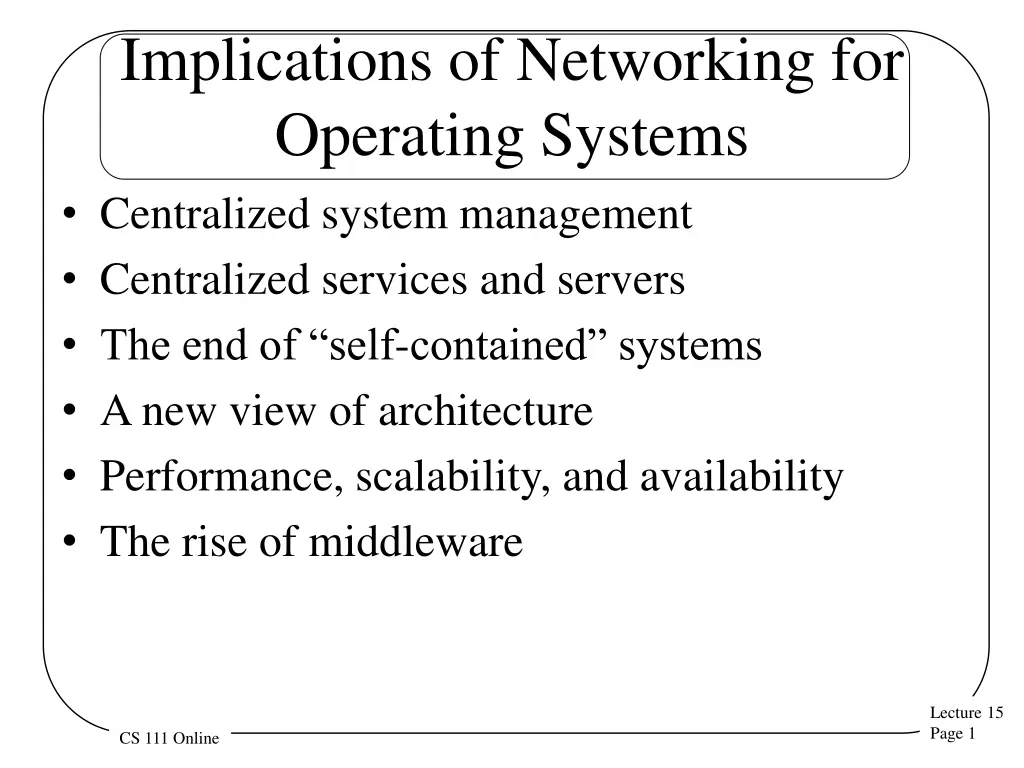
Networking Implications for Operating Systems: Centralized Management & Services
Explore the implications of networking for operating systems, focusing on centralized system management, services, and servers. Learn about the benefits and dangers of central management, centralized services, and the shift towards a new architectural view.
Download Presentation

Please find below an Image/Link to download the presentation.
The content on the website is provided AS IS for your information and personal use only. It may not be sold, licensed, or shared on other websites without obtaining consent from the author. If you encounter any issues during the download, it is possible that the publisher has removed the file from their server.
You are allowed to download the files provided on this website for personal or commercial use, subject to the condition that they are used lawfully. All files are the property of their respective owners.
The content on the website is provided AS IS for your information and personal use only. It may not be sold, licensed, or shared on other websites without obtaining consent from the author.
E N D
Presentation Transcript
Implications of Networking for Operating Systems Centralized system management Centralized services and servers The end of self-contained systems A new view of architecture Performance, scalability, and availability The rise of middleware Lecture 15 Page 1 CS 111 Online
Centralized System Management For all computers in one local network, manage them as a single type of resource Ensure consistent service configuration Eliminate problems with mis-configured clients Have all management done across the network To a large extent, in an automated fashion E.g., automatically apply software upgrades to all machines at one time Possibly from one central machine For high scale, maybe more distributed Lecture 15 Page 2 CS 111 Online
Benefits of Central Management Zero client-side administration Plug in a new client, and it should just work Since everything it needs to get going will be automatically delivered over the network Reduced (per client) costs of support Since all management info is centralized, rarely have to manually examine a client machine Uniform & ubiquitous computer services All data and services available from all clients Global authentication and resource domain Security benefits All important security patches get applied with certainty Individual users can t screw up their machine s security Lecture 15 Page 3 CS 111 Online
Dangers of Central Management Screw-ups become ubiquitous Loss of local autonomy for users Administrators gain extreme power So you d better be sure they re trustworthy and competent Security disadvantages All machines are arbitrarily reconfigurable from remote sites Encourages monocultures, which are susceptible to malware Lecture 15 Page 4 CS 111 Online
Centralized Services and Servers Networking encourages tendency to move services from all machines to one machine E.g. file servers, web servers, authentication servers Other machines can access and use the services remotely So they don t need local versions Or perhaps only simplified local versions Lecture 15 Page 5 CS 111 Online
Benefits of Service Centralization Quality and reliability of service Guaranteed to be up 24x7 Performance monitored, software kept up-to-date Regular back-ups taken Price performance Powerful servers amortized over many clients Ease of use No need to install and configure per client services Services are available from any client Allows thinner, cheaper clients Or allows existing clients to devote resources to their users Lecture 15 Page 6 CS 111 Online
Dangers of Centralized Services Forces reliance on networking Which is almost always available, but . . . Makes network congestion more likely Makes per-user customization harder Sometimes that s a good thing, though From a security perspective, one big fat target As opposed to lots of little skinny targets But automation of attacks makes this less important Can lead to huge privacy breaches Lecture 15 Page 7 CS 111 Online
The End of Self Contained Systems Years ago, each computer was nearly totally self-sufficient Maybe you got some data from some other machine Or used some specialized hardware on one machine Or shared a printer over the network But your computer could do almost all of what you wanted to do, on its own Lecture 15 Page 8 CS 111 Online
Now Vital Services Provided Over the Network Authentication Active Directory, LDAP, Kerberos, Configuration and control Active Directory, LDAP, DHCP, CIM/WBEM, SNMP, External data services CIFS, NFS, Andrew, Amazon S3, Remote devices X11, web user interfaces, network printers Even power management, bootstrap, installation vPro, PXE boot, bootp, live CDs, automatic s/w updates Lecture 15 Page 9 CS 111 Online
Benefits of Losing Self-Sufficiency Remote specialized servers often do the job better Your machine doesn t need to pay the costs of doing the work itself Advantages of centralized administration Generally possible if any networking available And, for modern use, relatively little is possible when networking isn t available, anyway Lecture 15 Page 10 CS 111 Online
Dangers of Losing Self Sufficiency Your device is a brick without connectivity Your security depends on the security of many others Worse, your privacy is dependent on a bunch of service providers In many cases, their business model is using your information . . . Harder, maybe impossible, to customize services to your needs Lecture 15 Page 11 CS 111 Online
A New View of System Architecture Old view is that we build systems Which are capable of running programs that their owners want executed Each system is largely self-contained and only worries about its own concerns and needs New view is that system is only a conduit for services Which are largely provided over the network Lecture 15 Page 12 CS 111 Online
The New Architectural Vision Customers want services, not systems We design and build systems to provide services Services are built up from protocols Service is delivered to customers via a network Service is provided by collaborating servers Which are run by remote providers, often as a business The fundamental unit of service is a node Provides defined services over defined protocols Language, OS, ISA are mere implementation details A node is not a single machine It may be a collection of collaborating machines Maybe widely distributed Lecture 15 Page 13 CS 111 Online
Benefits of This View Moves away from computer users as computer experts Which most of them aren t, and don t want to be A more realistic view of what modern machines are for Abstracts many of the ugly details of networks and distributed systems below human level Clarifies what we should really be concerned about Lecture 15 Page 14 CS 111 Online
Dangers of This Vision Requires a lot of complex stuff under the covers Many problems we are expected to solve are difficult Perhaps unsolvable, in some cases Higher degree of proper automated behavior is required Lecture 15 Page 15 CS 111 Online
Performance, Availability, Scalability There used to be an easy answer for achieving these: Moore s law (and its friends) The machines (and everything else) got faster and cheaper So performance got better More people could afford machines that did particular things Problems too big to solve today fell down when speeds got fast enough Lecture 15 Page 16 CS 111 Online
The Old Way Vs. The New Way The old way better components (4-40%/year) Find and optimize all avoidable overhead Get the OS to be as reliable as possible Run on the fastest and newest hardware The new way better systems (1000x) Add more $150 blades and a bigger switch Spreading the work over many nodes is a huge win Performance may be linear with the number of blades Availability service continues despite node failures Lecture 15 Page 17 CS 111 Online
Benefits of the New Approach Allows us to leap past many hard problems E.g., don t worry about how to add the sixth nine of reliability to your machine Generally a lot cheaper Adding more of something is just some dollars Instead of having some brilliant folks create a new solution Lecture 15 Page 18 CS 111 Online
Dangers of the New Solution Adds a different set of hard problems Like solving distributed and parallel processing problems Your performance is largely out of your hands E.g., will your service provider choose to spring for a bunch of new hardware? Behaviors of large scale systems not necessarily well understood Especially in pathological conditions Lecture 15 Page 19 CS 111 Online
The Rise of Middleware Traditionally, there was the OS and your application With little or nothing between them Since your application was obviously written to run on your OS Now, the same application must run on many machines, with different OSes Enabled by powerful middleware Which offer execution abstractions at higher levels than the OS Essentially, powerful virtual machines that hide grubby physical machines and their OSes Lecture 15 Page 20 CS 111 Online
The OS and Middleware Old model the OS was the platform Applications are written for an operating system OS implements resources to enable applications New model the OS enables the platform Applications are written to a middleware layer E.g., Enterprise Java Beans, Component Object Model, etc. Object management is user-mode and distributed E.g., CORBA, SOAP OS APIs less relevant to applications developers The network is the computer Lecture 15 Page 21 CS 111 Online
Benefits of the Rise of Middleware Easy portability Make the middleware run on whatever Then the applications written to the middleware will run there Middleware interfaces offer better abstractions Allowing quicker creation of more powerful programs Lecture 15 Page 22 CS 111 Online
Dangers of the Rise of Middleware Not always easy to provide totally transparent portability The higher level abstractions can hide some of the power of simple machines Particularly in performance Lecture 15 Page 23 CS 111 Online






















